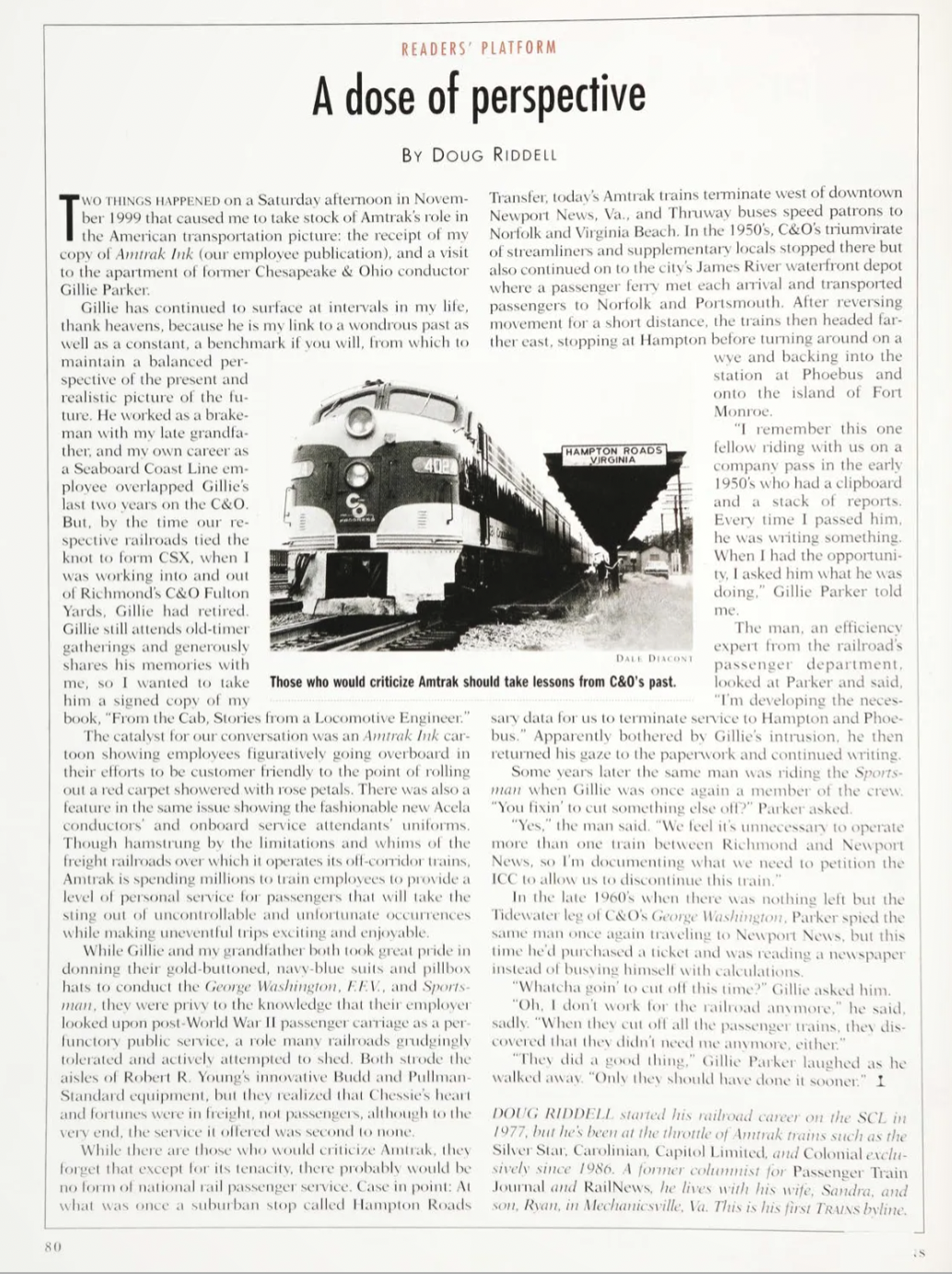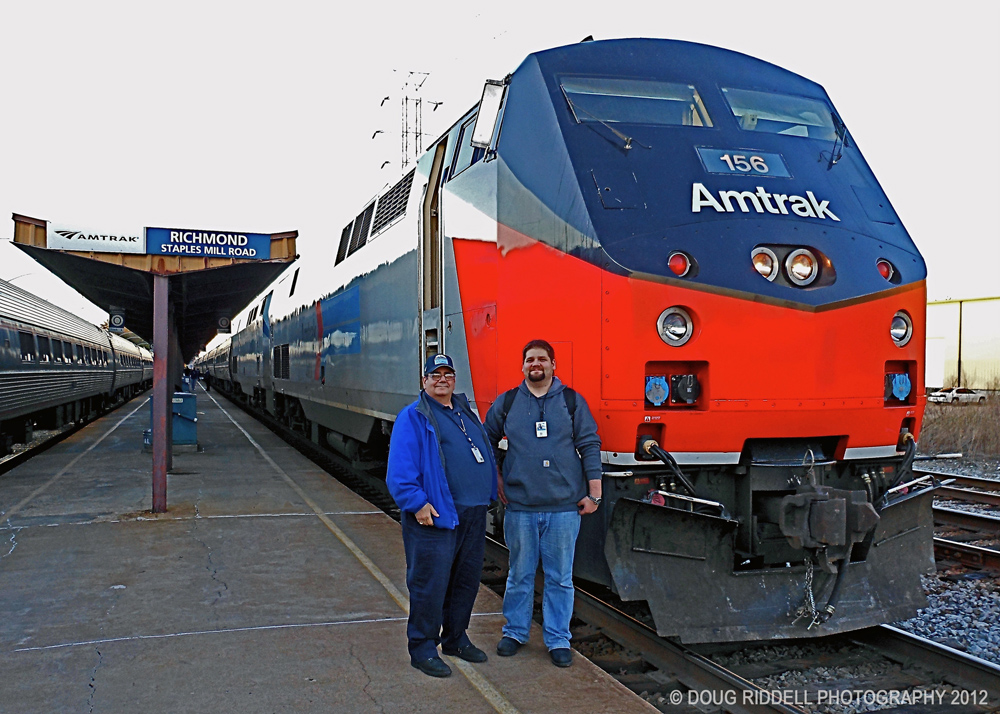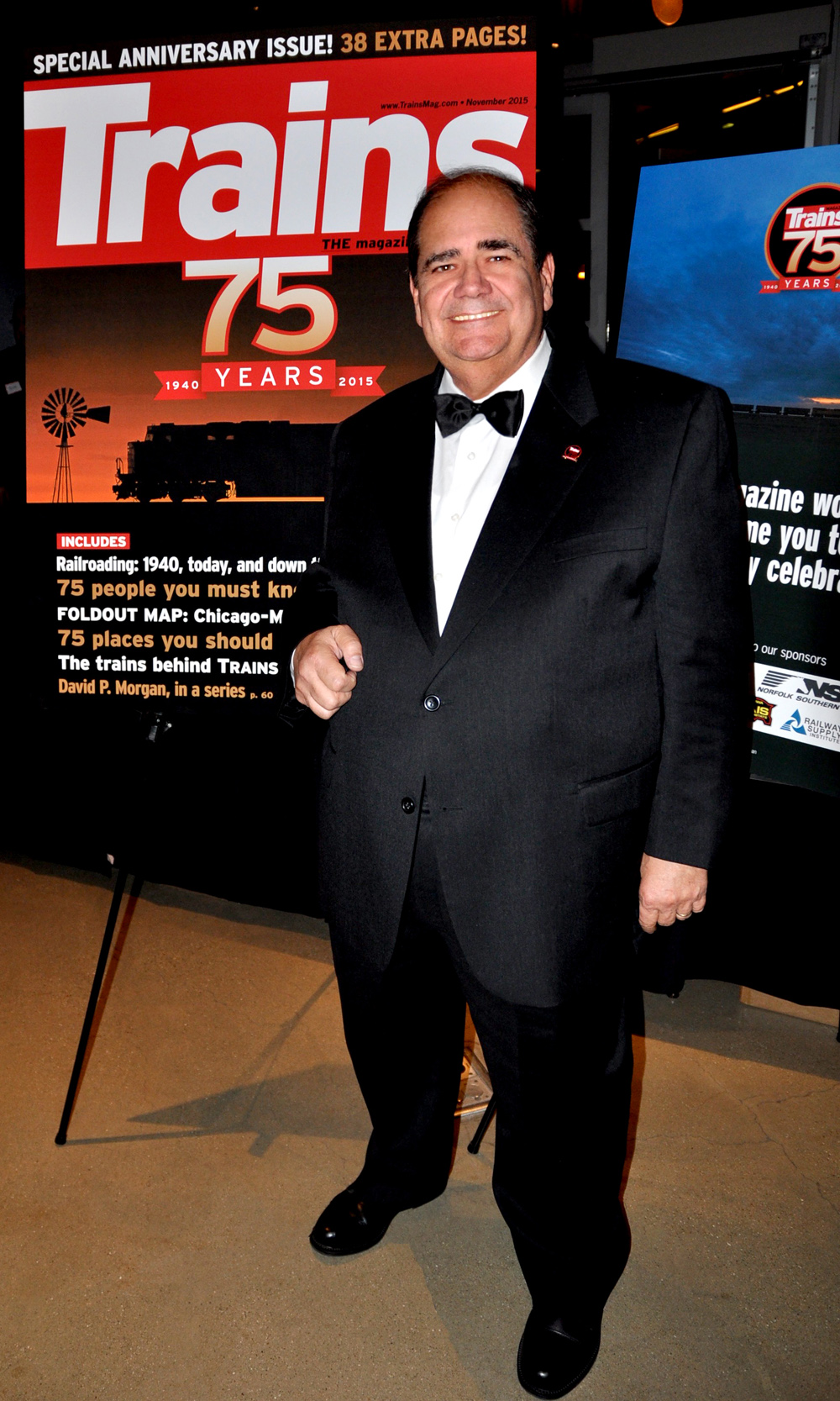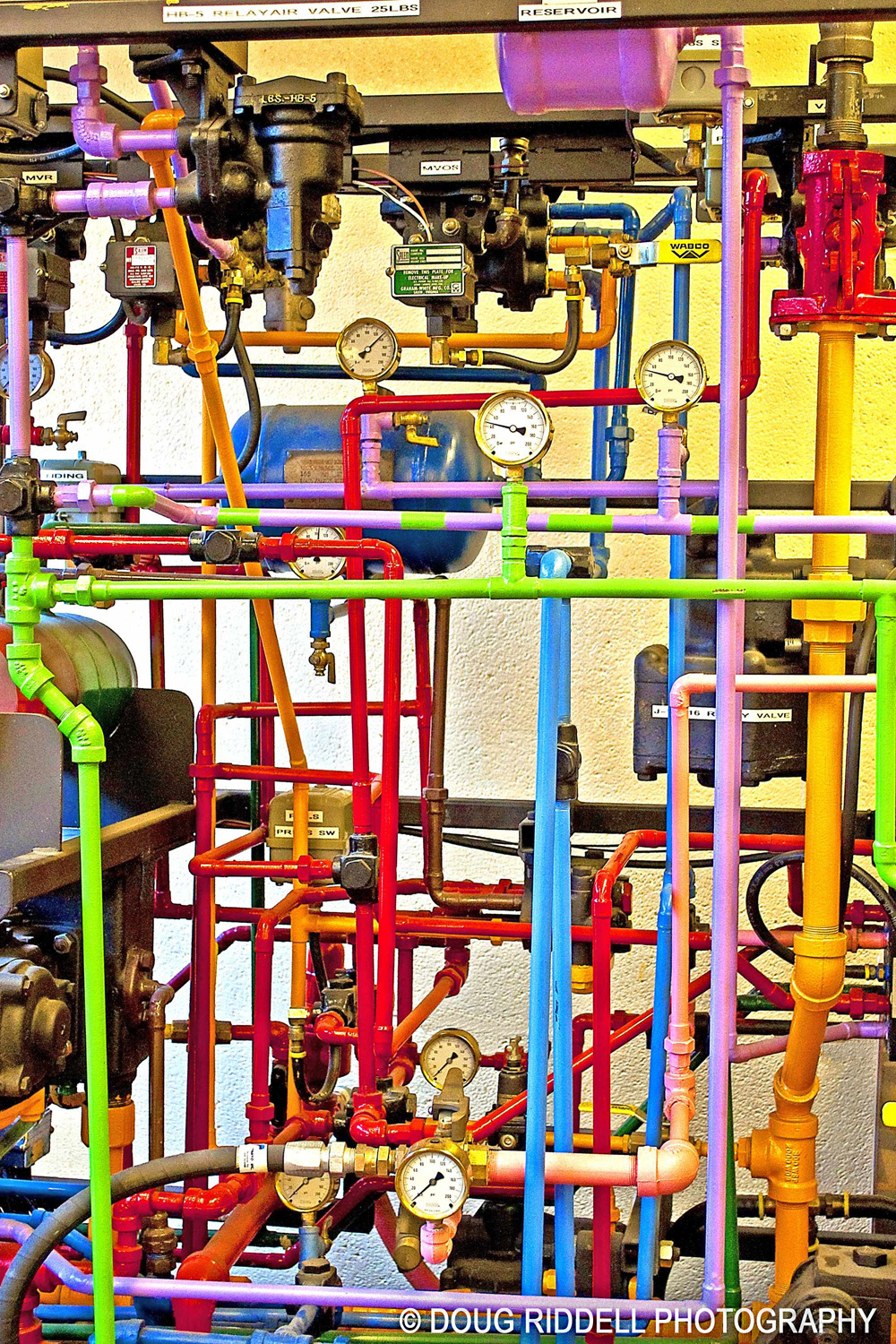What was your first byline in Trains?
Doug Riddell: My first byline in Trains appeared in the February 2000 issue: “A dose of perspective” (Readers Platform).
I’d just run into a retired Chesapeake & Ohio conductor, Gilly Parker, who shared a story with me. He’d worked passenger service between Richmond and Newport News in the early 1960s. An efficiency expert from headquarters was aboard his train one day, documenting the railroad’s plans to file for discontinuance of two others. The trains were eventually cut off, and the bean counter ironically lost his own job, because without them, he was no longer needed. My good friend, retired head of passenger service for Chessie, the late William E. Howes, read the story and later told me that he knew the details very well. It was Howes who let the man go. Talk about irony.
What’s your favorite locomotive and why?
Doug Riddell: Nothing rode like an E8 or E9, but I got to run them only briefly before they were all retired. Freight-wise, there was no comparison to EMD’s SD45. On SCL, we referred to them as Clydesdales, because you could couple them up to a brick building and they’d have it running track speed in no time. Those 20 cylinders played a symphony in three-quarter time. What a sound! My favorite though? Amtrak GE P42 No. 156. It’s my engine. When asked what locomotive I wished to have for my last run (as if I really had anything to do with the decision), I blurted out “Heritage unit 156 (with the red nose).” Having assisted my dear friend, Amtrak President Joe Boardman, as company photographer, people assumed I’d be accorded special treatment.
On Dec. 17, 2012, to my complete surprise, No. 156 was waiting for me to power the Silver Star at Washington Union Station to Richmond. Unknown to me, it had been held for two days at Ivy City, washed and waxed. I was floored and very moved. A week later, my son Ryan had it on the Capitol Limited, and was sideswiped by a CSX freight with a loose load of lumber, putting a big dent in her nose. A couple of years later, the 156 was damaged beyond repair in a crossing accident. She’s still my engine. Always will be. I keep a model of her on my desk.

Describe your love of railroading in six words or less.
Doug Riddell: Everything I’d dreamed of, and more.

What’s your fondest memory as a Trains contributor?
Doug Riddell: Discovering I was in the same issue as Richard Steinheimer. When I visited Stein and his wife Shirley Berman in Sacramento, not long before his passing, I told him how awed I was by his body of work and how proud I was to be featured in the same issue of the same magazine. As we signed and exchanged copies of our books, he looked up from the bed at me and said, “It’s been my honor to enjoy your work as well.”
What article received the biggest reader reaction?
Doug Riddell: I wrote a piece that appeared in Trains in early 2019, recalling how an irate passenger — seated in the Quiet Car of the 9 a.m. Acela from Washington to Boston — angrily threatened to have us thrown off the train because our conversation was disturbing him (we were prepping for a press conference in Philly). “And I can have the conductor do it, too. I’m a personal friend of Amtrak President Joe Boardman.”
Strangely, he didn’t realize it was Joe Boardman he was addressing. Joe, not realizing he had boarded the Quiet Car, sent me forward to find an open space in another coach. “I wouldn’t want to get thrown off my own train,” Joe added.
What didn’t appear in the article was that I ran into journalist Katie Couric, and in conversation, she said, “I’d love to meet Amtrak’s big kahuna. Can you introduce us?” I assured her I would. A few minutes later Joe and I returned. Before I could say a word, Joe stuck out his hand, grinned, and said, “Hi, Katie. I’m Joe Boardman — Amtrak’s big kahuna!” I thought I’d die as Katie, Joe, and her staffers roared. Amtrak’s Quiet Car had become fodder for the late-night talk show host. Also for a lot of Trains‘ readers. The responses were hilarious.
What advice would you give a new contributor?
Doug Riddell: Decide what you are, then give it your very best. Most importantly, determine who comprises your readership and direct your thoughts to them. Not to offend the mechanically inclined among you, but if I had to address an assemblage primarily made up of rivet counters, I’d be speechless (as hard as that may be to believe). I can tell you from personal experience why and how much I hated running a GE BQ-23-7 on the SCL for example. But when it comes to piston sizes, drawbar pull, or continuous traction ratings, I alert the dispatcher/editor to call out the helper engines to give me a shove because I can’t make the grade without them. I’m a teller of tales.















Oh, and Doug…the brake simulator picture….they don’t require us to go through all that anymore…electronic gizmos these days and all…but being color coded….as long as you could remember the system portions each color represents you could trace it out, I am pretty sure….of course…arcane terminology being what it is! But I am mechanically minded, so I will either learn it or else.
Oops, John Garrison: that last comment was supposed to have been meant for you. William McDonald, that’s for the dieting advice.
William McDonald,
Yes, I’ve been told (a few times) that I seem to have no problem finding words to say. LOL. No, I’m glad to be able to get people to listen to me when it comes to railroaders and railroads. Note, I put the employees first. They are my inspiration for just about everything I write about. Everyone has a story to tell, and every now and then, (when I listen, instead of talking), I hear some good tales I feel people would like to hear. My best to you.
As a fellow rail I can say you are the one Doug, who can say what all of us feel but can’t find words for….
Doug:
Both you and your son would be well advised to read and ACT on the following:
Visceral fat, also known as toxic fat, is hidden inside your body on and around your vital organs. Visceral fat can cause health issues such as high blood pressure, heart disease, diabetes and some cancers.
Better get interested in physiology as well as railroading. Your lives will depend on it.
Kevin Brady
You’re very kind in your assessment of my talents. Thank you. I have a friend who is an actor, who once told me that you did not get rich by being a famous celebrity. In that business, you got by by working steadily. I almost ended up on the West Coast as an announcer and actor, but just before I was to leave my hometown and go to LA, the job that I was going to have, disappeared. I was told I could still go out there and do bit parts on television and movies and voiceover work. Realization sat in, and I listened to the song by Dionne Warwick, Do You Know The Way To San Jose? Had I’ve been there, I would’ve been among thousands of others working as waiters, bartenders, or as the song says parking cars and pumping gas. Everyone knows what they want to do versus what they are capable of doing. The railroad is no different. It’s a good life, with a price to pay. I hear from people after all these years who tell me that reading my book, and following me in the magazine column, they were able to save themselves a lot of grief and uncertainty by accepting the fact that railroading, like so many other vocations, comes with a price. I’m glad you’re happy doing what you are doing. And I hope you’ll continue enjoying railroad from the sidelines, where you can truly enjoy railroading. My best to you. Doug.
Doug, you’re one of the reasons I’m still subscribed to Trains (and Classic Trains) after almost 60 years. Your firsthand understanding of the business and ability to write engagingly about it are matched by very few. Because of that, some years ago you and I corresponded when I was almost convinced to try railroading as a second career. But you were candid enough to make me realize that I was probably born at the wrong time; I probably would have had to survive employment with both Conrail and NS had I started at the age you did, and years later when I thought about it again, I probably wouldn’t have had the patience. So I stayed in the trucking business (even in semi-retirement) and I’ve enjoyed a lot of that, as well.
Ironically, in that capacity I was stranded in Buffalo for two days during a recent snow emergency (for which I blame Amtrak, partially), but I was also rescued by Amtrak at the end of it. Long story.
In any event, Doug, when I see your byline, you have my full attention.
Joseph Markfelder,
Thanks for the kind thoughts. You’ve found the secret to being a happy rail fan: the fun is in the enjoyment, however you do it. I wrote year ago in “From The Cab” about a doctor who as standing trackside with me as we awaited passage of the N&W J 611, when he said, “I’d like to trade jobs with you,” to which I replied, “And I’d like to trade paychecks with YOU.” We both laughed. I went on to point out that he got to witness what he wishes to, when he wanted to. If he got tired, he packed up and went home. When it was too hot or cold, he got to stay home. It’s your COMFORT ZONE. For some people (like me), devoting 35 years of my life was very hard some times, but I never felt that I wanted to quit, even though there were hardships. I had the love and understanding of a wife who recognized that railroading was what I was meant to pursue, and that anything else would leave me feeling that I’d betrayed my dreams. And then I worked with a guy who showed up to work with me one day, and after about an hour, asked where the nearest bus line was. When I pointed toward the highway, he said, “I quit,” and walked away. I’ve seen guys (and gals) finally give it up after five or ten years, forfeiting even a portion of Railroad Retirement. To your own self, be true. Be satisfied that nothing else would have made you happier. What more can I say. Best wishes.
Patrick Clark, yes and no. I’ll explain. During it’s overnight layover in Savannah, the Palmetto was serviced and fueled by a contractor. Once in its long life, the vendor at the time realized that it didn’t take a whole tank of diesel fuel to make the trip back to Washington, so he began experimenting. Each night he’d fill the locomotive with less and less fuel, pumping the excess back into the fuel truck, while the meter ran. Had he not become greedy, no one would likely have been the wiser–at least until it was noticed that the Palmetto had become a fuel hog, for some reason. After a while, the Palmetto began suffering shutdowns due to running out of fuel. Usually this happened between Richmond and Washington, on the RF&P, but once occurred on the SCL south of Richmond. This resulted in Amtrak, SCL, and local police in Savannah, observing the vendor at night, and it became obvious what was happening. The contractor was arrested and, to my knowledge, there was never again a problem with the Palmetto legitimately running out of fuel.
That said, when a train runs usually late, since the locomotive burns a lot of fuel by the hour, precautions are taken to insure that if necessary, additional fuel is added at some point short of the normal fueling location, to prevent a shutdown.
Did you really run out of fuel between Alexandria and Washington one time? Or is it just an obnoxious, persistent rumor?
Thanks, John Zwemer. I like to write about our love of trains because it’s something that we can all share.
When I was growing up that was my dream job to be an engineer on the railroad and operate trains but my career path shifted when I was a teenager and by that time railroads weren’t really hiring anyone or there would a waiting list of applicants a mile long which could be a few months or years and then I also wanted a job and career with steady hours and schedule. Still that feeling never really left me and I alway wonder what might have been if I had just decided to stay the course and follow my dream and desire to be a railroader and an engineer but who knows Anyhow my love of railroads and trains has been with me for my entire life and today as a retired person living in Florida my passion for trains is greater than ever and now have plenty of time to pursue my favorite hobby and pastime. Model railroader, railfan and collector train buff and photographer and train travelled. Everything trains and lol. A CTN. Which stands for Certified Train Nut Smile. Joseph C Markfelder
Before I moved to Florida,I used to visit family in Florida and would travel aboard the Silver Star from New York to Winter Park on the the Silver Star On one my return trips back to New York which would be one of the last ones as a visitor to Florida before I moved to Orlando I had the P 42 unit 156 pulling my train back to New York. I have the Kati N scale model in my Amtrak collection and I have 3 models of 156 including a 50th Anniversary edition that Amtrak painted for the occasion. I always liked this design and it was striking with the “ Bloody Nose” version inspired by the Southern Pacific locomotives. Great article and I love reading these stories which give us an inside look into the life and adventures of working for the railroad. Joseph C Markfelder
Thanks, Doug, for sharing so many of your memories with us. When things get to crazy in ’23-’24 a story or two from “In the Cab” brings relief from the crazies of today, not that were some of those in the ’70’s but will leave that for another day. Thanks again for all the rail tales.
Michael, I had to doggone near ace everything else to get a passing grade, to become an engineer, to make up for the airbrake portion. If you see an engineer, you know what he’s been through to be able to set up in that right hand seat. Thanks.
Thanks, Don. You’ve uncovered my secret: I see a picture, or remember an incident from my railroad career, close my eyes, and just begin writing. The words simply come out. I pretend I’m sharing a story with somebody on the other side of the magazine, as if we were face-to-face. Thank you so much for the compliment.
Mr.Riddell,
I have enjoyed the articles and stories of your railroading career in both Trains Magazine and Passenger train Journal for many years,You seem to write so effortlessly.Even in this 6 question interview you make the rails shine!I especially remember your Christmas and Holiday stories in PTJ back in the day when it was a monthly magazine.They were so heartfelt.Thank you for all the years of your tales of the rails,sincerely,Don Shappelle,Wilkes Barre,Pa.
Oh, boy I forgot about the air flow rack.